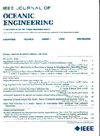Directionality of Tonal Components of Ship Noise Using Arctic Hydrophone Array Elements
IF 5.3
2区 工程技术
Q1 ENGINEERING, CIVIL
引用次数: 0
Abstract
The horizontal directionality of ship-radiated noise was estimated in the Canadian Arctic Archipelago using two 48-element bottom-mounted hydrophone arrays. Source levels (SL) were estimated using automated identification system data for distance and bearing with a geometric spreading propagation loss model for ships passing within 3 km of the arrays. Time-averaged received levels are calculated in 3-s increments for broadband (10–600 Hz) as well as selected narrowband tonal sources. Tonal components are identified with spectral analysis and algorithmically tracked in the time-frequency domain. From the difference of received levels and propagation loss, SLs are calculated and sorted by ship's bearing from each of the 96 array elements for both broadband and predominant narrowband sources. Broadband SL estimates ranged from 148 to 181 dB re 1北极水听器阵列单元舰船噪声调性分量的方向性研究
利用两个48单元底置水听器阵列估计了加拿大北极群岛船舶辐射噪声的水平方向性。利用距离和方位的自动识别系统数据,利用几何扩散传播损耗模型对经过阵列3公里范围内的船舶进行源电平(SL)估计。时间平均接收电平以3-s增量计算宽带(10 - 600hz)以及选定的窄带音调源。用频谱分析识别音调分量,并在时频域进行算法跟踪。根据接收电平和传播损耗的差异,根据船舶方位对宽带和主要窄带源的96个阵列元素中的每个元素进行SLs计算和分类。四艘机遇号的宽带SL估计范围为148至181 dB / 1 μPa2 m2。
本文章由计算机程序翻译,如有差异,请以英文原文为准。
求助全文
约1分钟内获得全文
求助全文
来源期刊

IEEE Journal of Oceanic Engineering
工程技术-工程:大洋
CiteScore
9.60
自引率
12.20%
发文量
86
审稿时长
12 months
期刊介绍:
The IEEE Journal of Oceanic Engineering (ISSN 0364-9059) is the online-only quarterly publication of the IEEE Oceanic Engineering Society (IEEE OES). The scope of the Journal is the field of interest of the IEEE OES, which encompasses all aspects of science, engineering, and technology that address research, development, and operations pertaining to all bodies of water. This includes the creation of new capabilities and technologies from concept design through prototypes, testing, and operational systems to sense, explore, understand, develop, use, and responsibly manage natural resources.
 求助内容:
求助内容: 应助结果提醒方式:
应助结果提醒方式:


